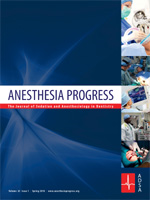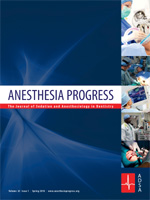[ad_1]

Anesthesia Progress volume 67 issue 4
The main aim of the study was to compare the time taken to intubate; the secondary focus was to assess the success of the first intubation attempt as well as the need for Magill forceps to aid in a successful intubation.
LAWRENCE, Kan. (PRWEB)
January 06, 2021
Anesthesia Progress – During surgical procedures involving the jaws and oral cavity, it is common for anesthesia providers to use nasotracheal intubation to secure the patient’s airway. Proper tube placement during this process is often more complex than conventional oral intubation and can be challenging. To assist with the time and ease of nasotracheal intubation, the introduction of a small camera on the end of the laryngoscope allows for live viewing of the anatomic structures within airway that could potentially obstruct passage of the tube.
Researchers from the Louisiana State University Health Sciences Center, New Orleans, published a study in the current issue of Anesthesia Progress that compared the use of direct laryngoscopy (DL) with that of video laryngoscopy (VL) for nasotracheal intubation. The main aim of the study was to compare the time taken to intubate; the secondary focus was to assess the success of the first intubation attempt as well as the need for Magill forceps to aid in a successful intubation.
The researchers randomly assigned 50 patients undergoing oral and maxillofacial surgery under general anesthesia to one of two groups: DL or VL. An independent observer with a stopwatch marked the time it took for successful intubation to be completed. The researchers also noted how many attempts were necessary and whether Magill forceps were needed.
The researchers found that the average time for successful intubation in the VL group was 94 seconds compared with 142 seconds in the DL group. The success rate on the first intubation attempt was 92% compared with 84% in the VL and DL groups, respectively. The need for Magill forceps was noted 56% of the time in the DL group and 16% of the time in the VL group.
The researchers concluded that VL took less overall time than DL, had a higher first-attempt success rate, and lowered the need for assistance with Magill forceps for nasotracheal intubation. Previous studies have assessed the benefits of VL over DL, with similar findings. The researchers believe that a larger, blinded sample size and the inclusion of additional variables, such as the impact on dental trauma, mucosal tears, and intubation difficulty score, would offer a more comprehensive comparison between VL and DL.
Full text of the article, “Comparing Video and Direct Laryngoscopy for Nasotracheal Intubation,” Anesthesia Progress, Vol. 67, No. 4, 2020, is now available here: https://meridian.allenpress.com/anesthesia-progress/article/67/4/193/450607/Comparing-Video-and-Direct-Laryngoscopy-for
###
About Anesthesia Progress
Anesthesia Progress is the official publication of the American Dental Society of Anesthesiology (ADSA). The quarterly journal is dedicated to providing a better understanding of the advances being made in the science of pain and anxiety control in dentistry. The journal invites submissions of review articles, reports on clinical techniques, case reports, and conference summaries. To learn more about the ADSA, visit: http://www.adsahome.org/.
Share article on social media or email:
[ad_2]

